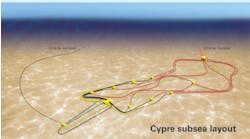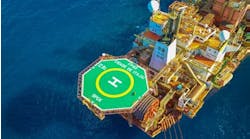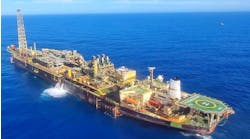David Shields
Contributing Editor
Platforms in Campeche Sound.
Moreover, the importance of offshore output is likely to increase over time, since any major oil discoveries are likely to be made offshore rather than onshore, particularly if the country ventures into deeper waters.
State-owned Petroleos Mexicanos (Pemex) has spoken tentatively of doing so (see Offshore, October, 1995), but there is no clear evidence as yet that it will. In fact, general director, Adrian Lajous, has said that first priority will be to rework existing fields, both in onshore Tabasco and offshore Campeche. Moreover, the company has plenty of other problems on its mind, particularly with the recent loss of a billion cubic feet per day of gas processing capacity at its plant at Cactus, in Chiapas state.
Many analysts are positively worried about developments at Pemex. Maria Fernanda Campa-Uranga, a geologist with 30 years of experience in Mexico's oil industry, forecasts Mexico's oil production could drop by 5% annually within a year or two, particularly if deepwater drilling and production do not become a priority as part of a renewed, modern drilling strategy.
"Many things are wrong. Wells are producing at their maximum level. The country's main deposits have been producing for 20 years and reached their peak in 1982. By 1986, Pemex acknowledged that onshore deposits were declining fast and offshore deposits were also beginning to decline. No major discoveries have been made nor brought onstream for over a decade. Studies of reservoirs are incomplete or are based on one single mathematical model," she notes.
Given their geological characteristics and their production history, Pemex's fields may indeed be expected to decline. Problems are compounded by the fact that offshore output comes from only 12 fields and more than 60% of it comes from just two giant fields, which are clearly past their peak: Cantarell, which accounts for 960,000 b/d and Abkatun, which produces about 300,000 b/d. These fields, like others offshore, require secondary and artificial recovery methods.
Of course, many other fields are known, including those on the Tabasco Littoral, which made the headlines just over a year ago, but nothing is being done to develop them. In the case of the Tabasco Littoral, this might seem strange, since the fields are close to existing oil and gas gathering infrastructure which brings Campeche production onshore.
Some deepwater structures, some of which may be giant fields, have been identified, but have not been drilled. So far, Pemex - with one exception - has worked only in shallow waters of up to 100 meters, but its current technology could be used in water depths of up to 500 meters. It has expressed its intention to do deepwater work and to offer the work to turnkey drillers, but has made no headway so far.
Political Pressures
The most acute and immediate concerns, however, have to do with current practices. "Pemex is producing above advisable levels in each of its fields. It pays little or no attention to isobars, to water levels or to gas traps. It is under political pressure to produce more and more, as the country seeks to earn ever more income," says Ricardo Gomez Saavedra, an ex-engineer and executive at Pemex's exploration and production division.
"The problem with immoderate exploitation is that deposits can be damaged and lots of oil is irremediably left in the ground. Many Pemex wells are flooded. The deposits much require better administration," Gomez added.
"In practice, however, Pemex has been trying to increase oil production for years and has not managed it. It may be able to sustain it or achieve marginal increases through secondary recovery, but it cannot make the big increases desired without bringing new discoveries onstream. In fact, in comparison to 1982, production has not increased at all," adds Campa-Uranga.
Official figure bear this out, particularly in Pemex's offshore area. Average production per well is down from 10,000 b/d to less than half, while the average for wells producing light crude is down from 8,500 b/d to about a third.
Almost all Mexicans are aware that Pemex is the government's cash cow and know that it is not making nearly sufficient investments in exploration and other priorities, including maintenance.
Campa-Uranga and Gomez Saavedra have joined with Francisco Inguanzo, an outspoken, controversial figure who once (from 1967 to 1976) headed Pemex's production division, to warn the general public of the dangers of falling output. Other reputed ex-directors of production at Pemex, such as Abundio Juarez and Walter Friedeberg, form the Pemex-Constitution 1917 pressure group.
Inguanzo worked with Pemex oil engineers on a study of Mexico's oil reserves in 1988, but the government has not acknowledged the results, which showed reserves well below half the official figure. Inguanzo fears that oil production will drop to a third of its current level in a few years. "Mexico will go from being an oil exporter to an oil importer to cover domestic fuel needs," he says.
His is not the only pressure group warning about the state of Mexico's oil patch. "Falling production on the country's most productive fields is a real risk," says Aurelio Tamez, a businessman who heads the National Association of Company Directors, which represents, among others, private engineering and oil service companies.
Under-investment in exploration, drilling and maintenance is forcing Pemex to overexploit its best fields and leave unattended some of its most promising areas. Pemex is constantly saying that Mexico has enough reserves for 48 years production, as if the oil were in some kind of underground pool, from which all the oil can be recovered, but that is not so. Reserves have not been certified externally and are being lost through poor recovery methods. Field characterization and simulation studies often just do not exist," according to Tamez.
Pemex remains confident
Pemex general director, Adrian Lajous, seems unmoved by the criticism and unrepentant about the state-owned company's strategies. Moreover, he has pretty good results, in terms of oil production and export income, to show for his year and a half at the helm of Pemex.
Total crude output fell slightly to 2.61 million b/d in 1995 due to hurricane damage, but this year jumped to 2.85 million b/d in the first half. Pemex has plans to increase it to 3 million b/d in the short term, though it is thought unlikely that this will be achieved for now in the light of the accident at the Cactus gas plant, which puts certain restraints on the whole Pemex system. Oil export income was $4.9 billion in first half 1996 and, due to greater output and better oil prices, seems certain to end the year well above the levels achieved in recent years.
Lajous has said there will be more exploration, development and new, large-scale projects at Pemex. Exploration will be concentrated in areas close to traditional producing areas. "We are going back to old fields, renewing exploration and demarcation there and studying their behavior closely," he says.
Pemex now has a new organizational structure in which each reservoir will have its own interdisciplinary work group and an administrator, who will subcontract much of the work. Their job will be to get "maximum economic value" from the reservoir. "This is the criteria that will have to orient our work as a company," according to Lajous.
Pemex must make a greater contribution to Mexico's economic growth, Lajous says. "The extraordinary capacity for creating income must be fully taken advantage of."
There will be more 3D seismological studies, integral field studies, horizontal drilling and use of other techniques which are already allowing Pemex to make savings. Pemex is currently reevaluating oil reserves and Lajous has promised to publish the results as they progress, beginning with offshore reserves, figures for which are to be published this year, he says.
Certainly, Pemex has already been applying artificial recovery and pneumatic and electro-centrifugal pumping methods extensively in its offshore area. It has also been drilling intermediate wells in a number of fields. These methods have also been criticized as expensive and as simply another way of getting fields to produce more than they should be producing.
However, they have allowed Pemex to offset output declines on several offshore fields. Moreover, production has jumped noticeably on Caan, Chuc, Taratunich, and Balam, four of the less mature of the 12 key offshore fields. This has been vital to recent increases in output.
Despite the criticisms, the warnings and the accidents, Lajous, it seems, has been providing results at Pemex that please Mexico's political establishment. That is why he still has the job, observers say.
Copyright 1996 Offshore. All Rights Reserved.







